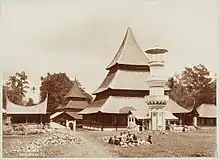Minangkabau Highlands
The Minangkabau Highlands is a mountainous area in West Sumatra, around the three mountains (Mount Marapi, Mount Singgalang, and Mount Sago) in central Sumatra, Indonesia. It is home to the Minangkabau people who refer it as Alam Minangkabau, or "the world of Minangkabau".[1] This area formed a kingdom known from at least the 7th century as Malayu.[2]

It is probable that wet rice cultivation evolved in the highlands long before it appeared in other parts of Sumatra, and predates significant foreign contact.[3] Inscriptions in the area have been found from the rule of Adityavarman (1347–1375).[4] The Dutch began exploiting the gold reserves in the highlands in the 1680s.[5] They dominated the trade in the area, severely restricting the trade outlets between the highlands and the ports on the coast between 1820 and 1899, bringing about a marked decrease in rice production.[6] The highlands consist of three major valleys: Tanah Datar Valley, Agam Valley, and Limapuluh Valley.[7]
The village of Belimbing in the highlands is well known for its examples of surviving Minangkabu architecture.[8]
References
- Ooi, Keat Gin (2004). Southeast Asia: A Historical Encyclopedia, from Angkor Wat to East Timor. ABC-CLIO. p. 887. ISBN 978-1-57607-770-2. Retrieved August 7, 2012.
- Wink, André (January 1, 2004). Indo-Islamic Society, 14th- 15th Centuries. BRILL. p. 47. ISBN 978-90-04-13561-1. Retrieved August 7, 2012.
- Miksic, John (2004). "From megaliths to tombstones: the transition from pre-history to early Islamic period in highland West Sumatra". Indonesia and the Malay World. 32 (93): 191. doi:10.1080/1363981042000320134.
- Barnard, Timothy P. (2004). Contesting Malayness: Malay Identity Across Boundaries. NUS Press. p. 66. ISBN 978-9971-69-279-7. Retrieved August 7, 2012.
- Borschberg, Peter (2004). Iberians in the Singapore-Melaka Area and Adjacent Regions (16th to 18th Century). Otto Harrassowitz Verlag. p. 156. ISBN 978-3-447-05107-1. Retrieved August 7, 2012.
- Schneider, David Murray; Gough, Kathleen (1961). Matrilineal Kinship. University of California Press. p. 476. ISBN 978-0-520-02529-5. Retrieved August 7, 2012.
- Backshall, Stephen (June 1, 2003). Rough Guide to Indonesia. Rough Guides. pp. 404–. ISBN 978-1-85828-991-5. Retrieved August 8, 2012.
- Waterson, Roxanna (1990). The Living House: An Anthropology of South-East Asian Architecture. Oxford University Press.